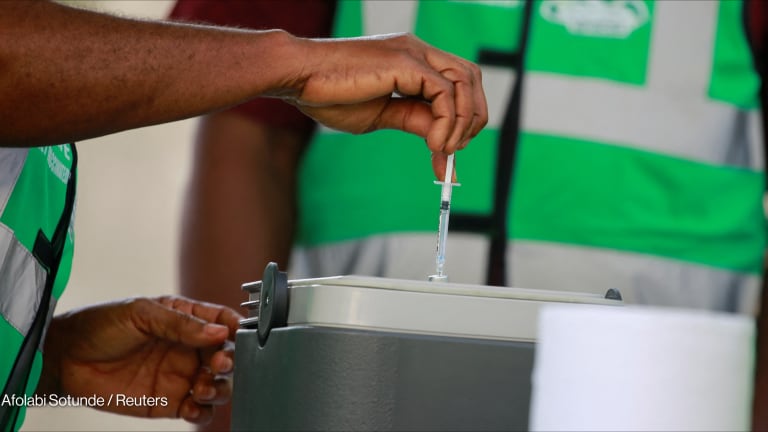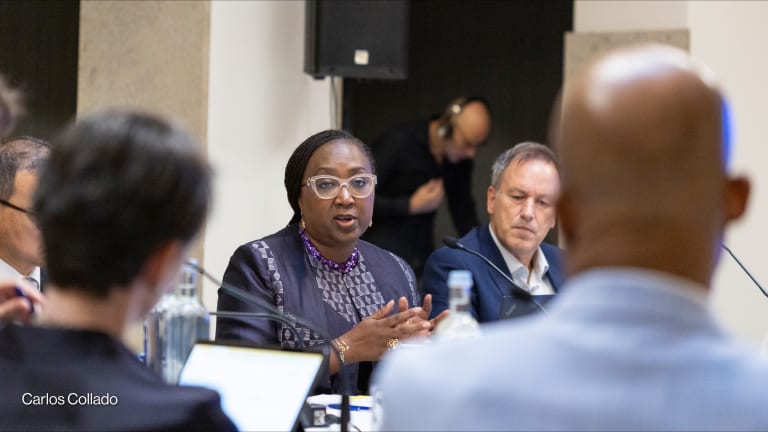
In Bangladesh’s thickly populated Rohingya refugee camps, the risk of COVID-19 infections and fatalities continues to run high, as vaccines are yet to reach them. Local authorities have been left to rely solely on strict lockdown measures to prevent rising infections, but health workers are also concerned about “deprioritizing” non-COVID-19 illnesses and potential counterproductive consequences of tightly enforced restrictions.
Sign up for Devex CheckUp
The must-read weekly newsletter for exclusive global health news and insider insights.
India’s ban on the export of AstraZeneca vaccines produced by the Serum Institute of India derailed COVAX — the global vaccine sharing scheme, which faces a global shortfall of 190 million doses by the end of June.
As a recipient country, Bangladesh was expected to receive 10.9 million AstraZeneca doses — out of 68 million, in total — from COVAX by May, of which some were to be used to immunize Rohingyas. In reality, the country of 160 million has not received a single AstraZeneca dose from COVAX so far — neither for its domestic use, nor for the nearly 1 million Rohingya refugees it hosts.
On May 31, a small shipment of 100,000 Pfizer doses arrived in Dhaka through COVAX, but they are unlikely to be distributed in areas where Rohingyas reside, beyond the capital city. A spokesperson for UNICEF, which was involved in delivering the shipment, said that these will be made available in Dhaka facilities only because of the ultra-cold chain requirements.
A coordinator with a United Nations Office for the Coordination of Humanitarian Affairs-run working group on Rohingyas said that his office does not expect any imminent immunization campaign for the refugees. Louise Donovan, a UN Refugee Agency spokesperson, said humanitarian actors were aiming for “a rapid delivery” of at least 2 million doses to Bangladesh. UNHCR recently warned about shortages of vaccines for refugees, including Rohingyas, in the Asia-Pacific region.
Repeated failed efforts
In early February, successful lobbying by the World Health Organization had led the Bangladesh government to revise its national vaccination plan to include Rohingyas as a target group. That meant “a humanitarian buffer,” established with COVAX as a last resort to immunize vulnerable populations neglected by respective authorities, would not be required for Rohingyas.
WHO expected the arrival of an initial allocation from COVAX in mid-March. Accordingly, a technical committee developed an action plan and a campaign strategy to inoculate refugees in collaboration with local health officials. On March 21, a coordination group led by OCHA emailed aid groups to prepare for the vaccination program in a week. However, days before the tentative Rohingya vaccination could begin, India placed a “temporary” hold on all exports of the AstraZeneca vaccines, forcing relevant stakeholders to postpone the program indefinitely.
In April, hope for Rohingyas rose again when the country director of the World Bank, which lent Bangladesh $500 million to purchase vaccines and acts as a lead contributor to the COVAX initiative, said Bangladesh would “very soon” receive vaccines under the scheme. Around the same time, Bangladesh foreign minister, AK Abdul Momen, told reporters the World Bank had assured Bangladesh 8 million doses by May.
But the promised vaccines never came.
Meanwhile, by the end of April, Bangladesh halted administering new doses, and late last month, reached a deal with China to purchase 5 million vaccines per month, but experts believe its priorities will be its domestic population, 97% of which remain unimmunized.
Rising infections, contrasting priorities
In June last year, a Johns Hopkins University modelling had predicted “a large-scale COVID-19 outbreak,” which had the potential to kill thousands in the tightly packed Rohingya camps. But defying odds, in the days since May 2020 when the first case was detected, there have only been 1,274 cases and 17 deaths confirmed in the camps that host roughly 1 million refugees.
“The rationale is simply that if you plan ahead, you can avoid a lot of things later.”
— Toha Bhuiyan, Rohingya health issues coordinator, Office of the Refugee Relief and Repatriation CommissionerHowever, more than half of the cases ever detected in the camps since the beginning of the pandemic were recorded in May 2021 alone. That prompted a wary local administration in Cox’s Bazar, where the camps are located, to impose a tight lockdown. The police have been asked to strictly control vehicular and individual movement except for health, food, and energy needs.
Meanwhile, two senior officials with a major medical humanitarian group argue other essential health services were deprioritized as health provisions were shifted to COVID-19 responses, despite low severity in the camps. This shift in priorities affects other vulnerable groups such as pregnant women and children, they said.
While they agree that mobility restrictions were necessary and a globally accepted practice, they pointed out that the police are often not considerate while determining medical emergencies for refugees. “It’s true you have to control the movement of your population,” one of the senior officials said. “But you also have to leave some room to ensure some needs that the population have.”
Both of the officials requested anonymity to avoid antagonizing the government.
One of the officials also said refugees have to go through disproportionately harsh treatment when they test positive. “When refugees approach for testing, sometimes it is not explained to them what it means. There’s no consent,” the first official added. “They don’t know what’s going to happen to them or their families. That means they are treated like prisoners ... There’s also no room for home quarantine [for Rohingyas who test positive], they are forcibly institutionalized — themselves and their families.”
Their concerns have merit: In a meeting on May 19 to decide on restrictions, the Office of the Refugee Relief and Repatriation Commissioner, or RRRC, a government office tasked with handling the Rohingya crisis, asked U.N. and aid agencies to “emphasize on institutional quarantine rather than home-based care,” minutes of the meeting accessed by Devex show.
Hardline measures, the two health officials argue, also discourage refugees from getting tested in the first place. Donovan of UNHCR also noted in an email response that lower numbers of refugees are coming forward for testing.
Meanwhile, the findings of a seroprevalence study on Rohingyas conducted around December last year by the Institute of Epidemiology Disease Control and Research, a government body, and WHO has not been released publicly or shared with stakeholders “because the government was not happy” with the results, the second health official requesting anonymity stated.
IEDCR previously retracted a similar study conducted among Dhaka city residents which showed “encouraging rates of seropositivity” toward developing “herd immunity.”
While a WHO spokesperson in Dhaka did not respond to repeated queries, the first health official from the humanitarian agency said that if the study found a high prevalence rate among Rohingyas, it would mean that the strict lockdown measures could not be justified.
But Toha Bhuiyan, who coordinates Rohingya health issues for RRRC, disagreed. “We were the first to impose a lockdown in Bangladesh when we restricted Rohingya camps at the early stage of the pandemic. When we saw a rise in cases again this time, we have preemptively enforced the lockdown so the virus remains in a controlled phase,” he said.
“The rationale is simply that if you plan ahead, you can avoid a lot of things later. Prevention is after all better than cure,” he added.







